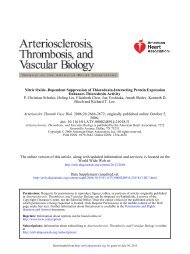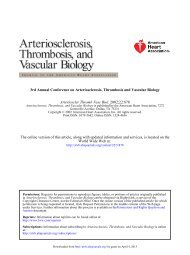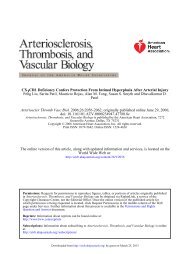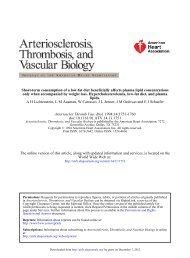Gamma-Glutamyl Transferase Another Biomarker for Metabolic ...
Gamma-Glutamyl Transferase Another Biomarker for Metabolic ...
Gamma-Glutamyl Transferase Another Biomarker for Metabolic ...
You also want an ePaper? Increase the reach of your titles
YUMPU automatically turns print PDFs into web optimized ePapers that Google loves.
<strong>Gamma</strong>-<strong>Glutamyl</strong> <strong>Transferase</strong><br />
<strong>Another</strong> <strong>Biomarker</strong> <strong>for</strong> <strong>Metabolic</strong> Syndrome and Cardiovascular Risk<br />
<strong>Gamma</strong>-glutamyl transferase (GGT) is a cell-surface<br />
protein contributing to the extracellular catabolism<br />
of glutathione (GSH). 1 The enzyme is produced in<br />
many tissues, but most GGT in serum is derived from the<br />
liver. 1 In the serum, GGT is carried primarily with lipoproteins<br />
and albumin. 2 Serum levels of GGT are determined by<br />
several factors: alcohol intake, body fat content, plasma<br />
lipid/lipoproteins and glucose levels, and various medications.<br />
1,3,4<br />
See page 127<br />
High levels of GGT have been associated in populations with<br />
increased risk of atherosclerotic cardiovascular disease<br />
(CVD). 5,6 In the current issue of Arteriosclerosis, Thrombosis,<br />
and Vascular Biology, Lee et al7 report that in 3451<br />
Framingham Study participants (mean age 44 years, 52%<br />
women) an increased serum GGT predicted the onset of<br />
metabolic syndrome and the occurrence of CVD and death;<br />
moreover, the highest GGT quartile experienced a 67%<br />
increase in CVD incidence. In this study the association of<br />
GGT concentrations with CVD and mortality remained significant<br />
after adjustment <strong>for</strong> traditional cardiac risk factors<br />
and C-reactive protein (CRP).<br />
One hypothesis <strong>for</strong> the relation of GGT levels and CVD<br />
holds that GGT itself is proatherogenic. 1 GGT has been<br />
reported to occur in atherosclerotic plaques, 8 which might<br />
support this hypothesis. The origins of GGT in plaques could<br />
be through influx of lipoproteins that carry it into lesions. One<br />
of the products of GSH hydrolysis produced by GGT is<br />
cyseinyl-glyceine, which can generate superoxidide anion<br />
radicals through its interaction with free iron. 9 This effect<br />
could promote atherogenesis via LDL oxidation. At present<br />
the postulated pathogenic pathways remain hypothetical and<br />
are yet to be substantiated.<br />
An alternative hypothesis that appears to be consistent with<br />
the findings of Lee et al7 is that elevations of GGT are a<br />
marker of the presence of the metabolic syndrome. Other<br />
workers have reported that high levels of GGT are associated<br />
with fatty liver, insulin resistance, type 2 diabetes, obesity,<br />
and other metabolic risk factors. There is growing evidence<br />
From the Center <strong>for</strong> Human Nutrition and Departments of Clinical<br />
Nutrition and Internal Medicine, University of Texas Southwestern<br />
Medical Center at Dallas.<br />
Correspondence to Scott M. Grundy, Center <strong>for</strong> Human Nutrition and<br />
Departments of Clinical Nutrition and Internal Medicine, University of<br />
Texas Southwestern Medical Center at Dallas, 5323 Harry Hines Boulevard,<br />
Y3.206, Dallas, TX 75390-9052. E-mail scott.grundy@utsouthwestern.edu<br />
(Arterioscler Thromb Vasc Biol. 2007;27:4-7.)<br />
© 2006 American Heart Association, Inc.<br />
Arterioscler Thromb Vasc Biol. is available at http://www.atvbaha.org<br />
DOI: 10.1161/01.ATV.0000253905.13219.4b<br />
Editorial<br />
Scott M. Grundy<br />
that the liver, which is the primary source of circulating GGT,<br />
is a key target organ <strong>for</strong> the development of the metabolic<br />
syndrome. An elevation of GGT is seemingly closely related<br />
to hepatic steatosis 10–13 ; the latter in turn is strongly associated<br />
with the metabolic syndrome. 14–18 The mechanisms<br />
whereby elevated GGT is related to hepatic steatosis have not<br />
been determined, but several possibilities have been proposed<br />
by Ortega et al. 19 For example, fatty liver could cause<br />
hepatocellular damage that would simulate the synthesis of<br />
GGT. Alternatively, excess fat in the liver could enhance<br />
oxidative stress, leading to overconsumption of GSH with a<br />
compensatory increase in GGT synthesis. Finally, a higher<br />
GGT production could be secondary to a low grade hepatic<br />
inflammation induced by hepatic steatosis.<br />
It must be noted that high levels of GGT are not the only<br />
hepatic biomarker of hepatic steatosis. Elevations of transaminase<br />
are common in patients with fatty liver with or without<br />
histological evidence of inflammation. 20–24 In addition,<br />
higher levels of serum transaminases in populations have<br />
been associated with the metabolic syndrome 25–30 and a<br />
higher risk <strong>for</strong> CVD. 31,32<br />
Other lines of evidence support a relationship between<br />
elevated serum GGT and the metabolic syndrome. 33 Thus the<br />
higher GGT levels are accompanied by more insulin resistance<br />
and greater risk <strong>for</strong> developing type 2 diabetes. 34–38<br />
<strong>Another</strong> important association between GGT and the metabolic<br />
syndrome is the finding that higher GGT levels occur in<br />
obese persons, particularly those with abdominal obesity. 39–44<br />
The connection between GGT and the metabolic syndrome<br />
extends to an association of higher GGT levels with hypertension.<br />
45–49 Thus, it appears that all of the major components<br />
of the metabolic syndrome are linked to elevations of serum<br />
GGT.<br />
The metabolic syndrome consists primarily of a group of<br />
atherogenic factors that commonly cluster in individuals. 50<br />
These include elevations of remnant lipoproteins, glucose,<br />
blood pressure, circulating inflammatory cytokines, and prothrombotic<br />
factors and low levels of high density lipoproteins<br />
(HDL) (Table). In addition, a large number of biomarkers<br />
have been reported to be associated with the metabolic<br />
syndrome (Table). These include parameters of obesity and<br />
products released by adipose tissue, plasma insulin levels and<br />
insulin-like growth factors, liver enzymes, C-reactive protein<br />
and circulating metabolites, several components of circulating<br />
lipoproteins, microalbuminuria, and markers of increased<br />
cellular inflammation. 51–66 The status of these biomarkers as<br />
causative factors, either in generation of the metabolic syndrome<br />
or directly in atherogenesis, at present is uncertain.<br />
Some of them have been implicated as causes, but others as<br />
a reflection of a metabolic abnormality.<br />
Downloaded from<br />
http://atvb.ahajournals.org/ 4 by guest on November 15, 2012














